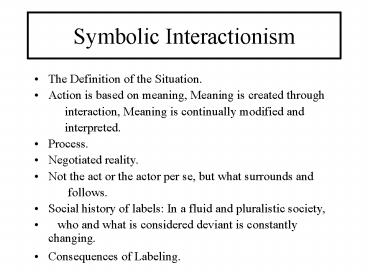Symbolic Interactionism - PowerPoint PPT Presentation
1 / 11
Title:
Symbolic Interactionism
Description:
Social history of labels: In a fluid and pluralistic society, ... The key question in the social control theory is not why people commit crime and ... – PowerPoint PPT presentation
Number of Views:478
Avg rating:3.0/5.0
Title: Symbolic Interactionism
1
Symbolic Interactionism
- The Definition of the Situation.
- Action is based on meaning, Meaning is created
through - interaction, Meaning is continually
modified and - interpreted.
- Process.
- Negotiated reality.
- Not the act or the actor per se, but what
surrounds and - follows.
- Social history of labels In a fluid and
pluralistic society, - who and what is considered deviant is
constantly changing. - Consequences of Labeling.
2
Labeling Theory
- - Labeling theorists began exploring how and why
certain acts were defined as criminal or deviant
and why other such acts were not. - - Such theorists viewed criminals not as evil
persons who engaged in wrong acts, but as
individuals who had a criminal status placed upon
them by both the criminal justice system and the
community at large. - From this point of view, criminal acts thus
themselves are not significant, it is the social
reaction to them that are.
3
Labeling Cont.
- Deviance and its control then involves a process
of social definition which involves the response
from others to an individual's behavior which is
key to how an individual views himself. - Labeling theory focuses on the reaction of other
people and the subsequent effects of those
reactions which create deviance. - When it becomes known that a person has engaged
in deviant acts, she or he is then segregated
from society and thus labeled, "whore," thief,"
"abuser," "junkie," and the like.
4
More on Labeling Theory
- This process of segregation creates "outsiders",
who are outcast from society, and then begin to
associate with other individuals who have also
been cast out. - When more and more people begin to think of these
individuals as deviants, they respond to them as
such thus the deviant reacts to such a response
by continuing to engage in the behavior society
now expects from them. - Visibility and Stigma (Master Status)
- Stickiness of labels
- Strained interaction
5
Effects of Labeling
- "Looking-Glass Self"
- Self-fulfilling Prophecy
- By categorizing certain people in certain
situations as deviant, we assume (create) the
reality of the norms and they reflexively produce
the deviant reality of the emerging situation. - Law of Economy Once categorized, we resist other
interpretations of behavior. - Law of Consistency Once categorized we will
organize past and future behavior in line with
the new category (retrospective interpretation)
6
Social Control Theory
The key question in the social control theory is
not why people commit crime and delinquency, but
rather why dont they? Why dont people conform?
7
Social Control Theory 2
The most detailed elaboration of modern social
control theory is attributed to Travis Hirschi
who wrote the 1969 book, Causes of Delinquency.
8
Causes of Low Self-Control
- We are all born without self-control
- Self Control is established in early childhood
- Causes must be in early childhood
- There is a lack of adherence to social norms
- Biology? NOT according to Hirschi
9
Basic Premise
Hirschi argued that delinquency should be
expected if a juvenile is not properly socialized
by establishing a strong bond to society,
consisting of
- Attachment to others
- Commitment to conventional lines of action
- Involvement in conventional activities
- Belief in the moral order and law
10
(No Transcript)
11
Social Bond Theory Updated
More recently, Hirschi wrote with Michael
Gottfredson that the principal cause of deviant
behaviors is ineffective child rearing, which
produces people with low self-control.




























![❤️[READ]✔️ Festschrift in Honor of David R. Maines (Studies in Symbolic Interaction, 57) PowerPoint PPT Presentation](https://s3.amazonaws.com/images.powershow.com/10042805.th0.jpg?_=20240530082)


